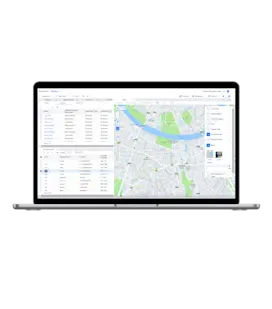Uitgelicht in deze blog
Everything You Need To Know about the Routing and Scheduling Software Implementation Process
Everything You Need To Know about the Routing and Scheduling Software Implementation Process
8 Nov 2024
Aptean Staff Writer
Many transportation professionals have stood where you do right now, on the precipice of investing in routing and scheduling software to slash logistics costs, boost service and increase efficiency. Like you, they knew the potential benefits and had seen the return on investment (ROI) projections. But they were daunted by the prospect of a lengthy software project and disruption in their already hectic daily operations. And so, they delayed, continued doing things the old way for a “little while longer,” putting off the inevitable.
Unfortunately, the cost of doing nothing in such a situation can be dire. Operations that don’t move with the times silently bleed profit from every corner of the business. Until they’ve run dry altogether, they’re passed by competitor after competitor, each of which used technology to elevate their service levels while reducing costs and increasing profitability.
Large implementation projects can indeed be intimidating and it’s understandable that many business leaders don’t feel that their organizations are able to take them on amidst the daily grind. But we’re here to tell you that digital transformation doesn’t have to be a slog, and the ends justify the effort you put in. With the right preparation, the right team assembled and the right vendor in your corner you can soon be reaping all the benefits of route optimization software, without the hassle.
This blog will provide you with a comprehensive guide to the implementation process of routing and scheduling software. We’ll break down the steps, share best practices and highlight key considerations to help you navigate the implementation journey smoothly.
So, without further ado, let’s dive in and get your business on the right track.
Implementation Timelines and Process Steps
First off, let’s start with the practicalities. Understanding exactly what a routing and scheduling software implementation will look like for your business is crucial in allaying any concerns from internal stakeholders.
Timeline Overview
The most common question we hear when it comes to implementing routing and scheduling software, is “How long does it take?” And the honest answer is that the timeline can vary significantly depending on the complexity of your integration needs, the level of customization required, the availability of internal resources and the vendor you choose.
Remember, you’re implementing a technological game-changer for your business—if you want it done right, it will take a little time. So be wary of any provider that tells you every business is done and dusted in a couple of weeks. Setting realistic expectations is key to a smooth transition when implementing routing and scheduling software.
For example, a small business with straightforward requirements might complete the implementation in as little as eight weeks. On the other hand, a larger enterprise with complex logistics and multiple integration points could take closer to six months. It’s essential to plan accordingly and set these realistic expectations so you encounter less initial pushback and fewer surprises down the road.
Integration with other systems, like enterprise resource planning (ERP) or a transportation management system (TMS), can also lengthen your timeline, so be sure to take your tech stack needs into account. Let’s break down the implementation process into its key phases to better understand where this time is spent.
Critical Phases of the Implementation Process
1. Discovery Phase
The discovery phase involves understanding your current routing processes, pinpointing inefficiencies and defining what success looks like. During this stage, your team will work with your chosen vendor to assess your existing systems, workflows and any specific goals you have. Key performance indicators (KPIs) are also established in this phase to measure success. It’s crucial to gather input from all stakeholders to ensure the software meets your specific requirements.
2. Planning and Configuration
During this phase, you’ll work with your vendor on configuring the software to align with your business processes and goals. This includes setting up user roles, defining routing rules and integrating with existing systems. Detailed planning here is critical—ensuring you get the best ROI once the software is up and running.
3. Testing, Training and Refinement
Before going live, it’s essential to test the software thoroughly. This phase involves running pilot tests, getting staff trained on the new software and making necessary adjustments based on feedback. It’s better to identify and fix issues now rather than after full deployment. It's also a chance for you to finetune the system for maximum efficiency and ensure all processes are properly aligned with the software.
4. Go-Live and Post-Launch Support
Now, it's time to go live. Although implementation is complete at this stage, the work is not yet done. Post-launch support is essential to ensure the continuous smooth running of your software. During this time, the vendor typically provides hands-on assistance to resolve any teething problems or issues.

Key Stakeholders in the Implementation Process
Implementing routing and scheduling software is a team effort and several internal stakeholders play crucial roles in ensuring its success. You may face reluctance to take staff away from their daily activities, but having the right people in the room, first time, will pay dividends in the end.
Internal Teams That Need to Be Involved
First, we have the C-suite executives—think CEO, CIO and CFO. Their role is not just about green lighting the project, but about shaping its direction, aligning it with the company’s strategic goals and allocating the necessary budget and resources. Their endorsement is not just vital, but integral to securing the attention and backing the project needs.
Next, we have the implementation project managers. These individuals are the linchpin of the operation. They create comprehensive project plans, set milestones, allocate resources and ensure the project stays on track. Their role as the communication bridge between stakeholders, informing everyone about the project’s progress and any potential roadblocks, is crucial.
Another important team to account for is IT. Whether you have in-house resources or will be working with an external vendor, your IT stakeholders should be involved from the very beginning. Not only will you need them to ensure seamless integration between your new software and existing systems, but they’ll likely be involved in any data cleansing tasks you undertake, too.
And don’t forget the end users—the people who will either interact with the software daily, or have their roles impacted by it. Their needs and feedback are essential in shaping the selection and customization of the software. Involving them early in the process helps identify specific requirements and potential challenges. Within this group there should be representatives for your route planning, dispatch, transportation and customer service teams.
Vendor Involvement and Support
Your choice of software vendor is pivotal in the smooth sailing and success of your implementation process. They provide the experienced consultation, best practice advice, technical expertise and support needed to get the software up and running—without burning out everyone on your team. This includes everything from initial setup and configuration to comprehensive training and support to ensure your team can use the software effectively.
So, what do you need to consider to ensure you pick the right vendor partner?
Check for a proven history of successful implementations. Even better if they can provide customer testimonials or references for businesses that are similar to yours.
Ask them about their implementation process. A good vendor should have a step-by-step, tried and tested approach that plans for every key phase.
Don’t underestimate rapport and culture fit. In early conversations consider how you feel about the people you’re engaging with—you’re likely to be working closely with them for the next few months so you’ll need to feel supported and comfortable.
Then, once you’re in the implementation process, it’s crucial to establish clear communication channels with your vendor. Regular check-ins and updates can help address issues promptly and keep the project on track, while in-person training or go-live support can be vital for larger implementations.
Best Practice Tips To Avoid Common Challenges and Delays
Even with the best planning and all the right people involved, delays and issues can happen. Here are some tips to avoid common pitfalls in your routing and scheduling software implementation.
1. Weed Out Data Quality Issues
Poor data quality is not just a common issue, it's a critical one. It's akin to trying to build a house with weak foundations—it's bound to cause problems. Similarly, your software won't function as intended if the data it’s drawing from is inaccurate or incomplete. To avoid this, ensure your data is clean and precise before starting the project. This means verifying addresses, ensuring up-to-date customer information and checking that all relevant data points are correctly formatted. You’ll also want to consider if your data is consistent across systems. For example, one system might use “Street” while another uses “St.” for addresses—you’ll be handicapping your routing and scheduling system from the start if it’s receiving unreliable data. In short, investing time in data cleansing upfront can save you a lot of headaches down the road.
2. Gain Early Stakeholder Buy-In
We’ve already mentioned who needs to be involved with the implementation process itself, but you also need to consider a wider awareness and communication effort. Without organization-wide support, your project will meet resistance and delays, and the software will never deliver its full potential. It's like trying to steer a ship without the crew on board. To prevent this, engage all relevant parties early in the process. This includes everyone from route planners to drivers and even customer call handlers. Keeping them informed about the project's goals, progress and benefits will make change management during the implementation easier and improve eventual software adoption. The implementation process is likely to cause some disruption to everyday activities for a while, so regular updates and open communication can help build support for the project and ensure everyone is pulling in the same direction.
3. Ensure Comprehensive Training
If your team isn't comfortable using the new software, they might revert to old methods. And it’s completely understandable for them to stick with what they know if they haven’t been properly shown how to interact with the new system—to them it’ll seem like the quicker and easier option. To avoid this, it's crucial to invest in thorough training for all users. This is not just a step; it's a cornerstone of the implementation process. This includes initial training sessions as well as ongoing support and resources. Consider vendors that provide user manuals, refresher courses and helpdesk or in-product support for any questions that arise. The more confident your team is with the software, the smoother the implementation will be and the quicker you’ll see the benefits.
4. Plan Ahead To Mitigate Integration Challenges
Integrating the new software with your existing systems can be complex. It's like trying to fit a new piece into a puzzle—it must align perfectly, or the entire picture isn’t complete. This means ensuring customer information, delivery schedules and inventory levels are consistently updated across all systems, as well as integrating with telematics so that more intelligent routing decisions can be made based on real-world information. With all these necessary integrations, it’s easy for delays or unexpected issues to crop up. To counter this, ensure you ask compatibility questions during the shortlisting stage, prioritize getting your IT team and software vendor in sync from the beginning, and consider security and authentication methods early in the process. Clear communication and collaboration between all parties are crucial to overcoming these challenges.
5. Complete Thorough Multi-Phase Testing
There’s nothing worse than only finding out something doesn’t work as you expected when all eyes are focused on your new software during go-live. Thankfully, in-depth testing acts as a dress rehearsal—helping you avoid those last-minute emergencies and ensure smooth rollout. In particular, break testing into phases to cover different areas: integration testing to verify compatibility with existing systems, system testing to check overall functionality and configuration, and user acceptance testing to confirm the software meets your team’s real-world needs. Encourage a wide range of users to participate in the testing process, providing feedback from multiple perspectives.
6. Allocate Resources Wisely
One of the most overlooked steps in implementing routing and scheduling software is planning for proper resource allocation. Without a clear view of how much time each stakeholder will need to dedicate and what skills are essential at each stage, you risk running into project delays, decline in operational performance and burnout among team members. To mitigate this, assign timeframes for each task, ensure everyone understands their responsibilities and plan for delegation of day-to-day work. If your internal resources are limited, consider contracting with external specialists for certain tasks, like data integration or project management. Effective resource planning doesn’t just keep the project on track; it also ensures your team has the support and clarity they need to stay productive throughout the implementation process.
5. Embrace Continuous Optimization—Implementation Is Never Truly “Done”
Viewing software implementation as a one-time project can limit its long-term value. In reality, your routing and scheduling software should evolve alongside your business—adapting to new demands, process improvements and customer expectations. Without a commitment to ongoing optimization, you risk falling behind in efficiency and missing out on potential gains the software can provide over time. To maintain optimal performance, plan regular check-ins with your vendor and internal teams to identify any issues or areas for improvement. This might include upgrading features, integrating with new systems or re-training your team to take advantage of advanced functionalities. Implementing new technology isn’t just about getting it up and running; it’s about maximizing ROI, year after year.
Remember, a little preparation goes a long way in avoiding common pitfalls and keeping your project on track. Overcoming these challenges not only ensures a successful implementation but also boosts team confidence and efficiency, and ultimately, the success of your project and the benefits you achieve in the long run.

Benefits of Choosing Cloud Deployment for Your Implementation
One big implementation decision you’ll need to make before starting on your routing and scheduling software implementation is how you deploy your system: on-premise or in the cloud. For most businesses this should be a simple choice as cloud software has become a staple for smooth digital transformations and offers numerous advantages that can significantly enhance your business operations. Let’s dive into some of the key benefits and why they matter.
Scalability and Flexibility
One of the standout benefits of cloud deployment is its scalability, empowering you to adapt to changing market conditions. Imagine your business experiences a sudden surge in demand—perhaps during a holiday season or a special promotion. With cloud-based solutions, you can quickly scale up your resources to meet this increased demand without significant upfront investments in hardware. Conversely, if demand drops, you can scale down just as quickly, ensuring you only pay for what you use. This flexibility allows you to adapt rapidly to changing operational needs, putting you in control of your resources.
Enhanced Collaboration
Cloud-based solutions facilitate better collaboration among teams. Since data and applications are accessible from anywhere with an internet connection, employees can work together seamlessly, regardless of their physical location. This is particularly beneficial for businesses with remote or distributed teams—for example, you can centralize your route planning function instead of spreading it across depots. Real-time data access also ensures everyone is on the same page, improving decision-making and productivity.
Improved Security
Contrary to some misconceptions, cloud deployment can enhance your security posture, giving you peace of mind. Reputable cloud providers invest heavily in security measures, including data encryption, multi-factor authentication and regular security audits. They also offer robust disaster recovery and backup solutions, protecting your data against loss or breaches. By leveraging these advanced security features, you can safeguard sensitive information more effectively than traditional on-premise solutions, giving you confidence in your data security.
Business Continuity
Cloud deployment enhances business continuity by providing reliable backup and disaster recovery options. In the event of a hardware failure, natural disaster or other disruption, cloud services ensure your data and applications remain accessible. This minimizes downtime and helps maintain operational continuity, critical for customer trust and satisfaction.
Faster Updates and Access to New Features
With cloud deployment, staying up to date is effortless. Cloud-based software providers manage updates and improvements centrally, ensuring you have access to the latest features and security enhancements without manual intervention. This eliminates the hassle of coordinating system updates with your IT team, which can be time-consuming and disruptive. Faster updates mean your routing and scheduling software will continuously improve, often with minimal downtime, allowing you to leverage new functionalities that enhance efficiency and drive your business forward.
Your Roadmap to a Successful Routing and Scheduling Software Implementation
Implementing routing and scheduling software is more than a technological upgrade—it’s a strategic shift that can transform how your business operates and competes. While the journey might seem daunting, careful planning, full team buy-in and cloud deployment can make the process smoother and more impactful. By addressing potential pitfalls head-on, from data quality and change management to integration and training, you’re not just investing in software; you’re building a resilient, adaptable foundation for growth.
To truly succeed in your routing and scheduling implementation journey though, you must choose the right software partner. A vendor with extensive experience and a proven track record in your industry will provide you with the knowledge and insights needed to succeed in each phase of the process. From the initial discovery phase to the final go-live, your vendor will play a key role in ensuring your new software aligns with your business goals and seamlessly integrates into your operations. In short, their expertise can mean the difference between a smooth implementation, and one filled with costly delays.
What’s more, a successful partnership doesn’t end once the software is live. Ongoing support is crucial for long-term success. Having a dedicated vendor that provides ongoing technical support, best practice advice, product development and innovative feature upgrades ensures that your system continues to run seamlessly at all times and moves with the times—maximizing your long-term ROI and driving profitability.
Choosing a vendor like Aptean means your success will be a priority. With more than 30 years of experience building best-in-class routing and scheduling software and thousands of happy customers across the world, we’re ready to help you master your logistics challenges. Don’t settle for less—partner with us for the support and expertise you need to transform your routing and scheduling processes successfully.
Ready to take the next step? Our expert teams can guide you through the process with confidence and ensure your software implementation goes off without a hitch. Reach out to us for your free, no-obligation consultation today.
Related Content





Bent u klaar om uw bedrijf radicaal te veranderen?
We hebben gespecialiseerde TMS-oplossingen waarmee u elke uitdaging in uw branche aankunt.



